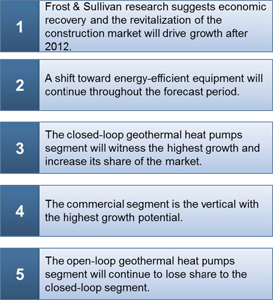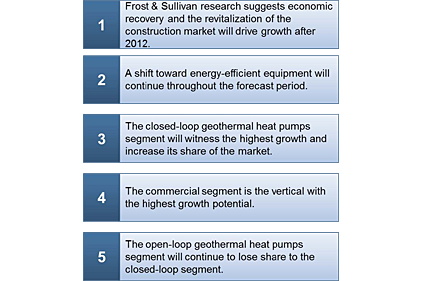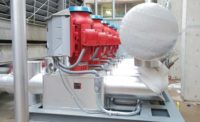
|
Within the last five years, geothermal heating and cooling has seen an increased level of interest. With firms more cost-conscious, green initiatives receiving more media attention and tighter market conditions, business leaders have sought ways to decrease operating expenses across the board and some of them are turning to geothermal solutions for their climate control.
As with any solution, geothermal heating and cooling has its pros and cons. It’s higher efficiency and lower operating costs are counter-balanced by the high initial expense incurred during installation. Geothermal heating and cooling solutions can provide adequate climate control for a facility, but the systems do not transform any energy into electricity, so reliance on the grid for appliances and electronics is still necessary.
These systems typically cost at least twice as much as their conventional counterparts and require significant land commitment to house the underground loops. Land requirements can be reduced by using vertically oriented loops, but that method significantly increases the install costs through drilling. In the case of installation proximate to water sources, loops can be run the cheapest through the body of water but must be carefully and clearly marked to avoid damage by anchoring boats.
Operating expenses are typically low enough to show a profit within a 3-to-10-year period The pump mechanism has a life expectancy of 25 years and the loops are projected to last 50 years. The mechanism has very few moving parts, so additional efficiency can be realized through maintenance cost savings and the system is not susceptible to weather damage as loops are buried.
Additionally, the U.S. Federal Energy Policy Act of 2005(H.R. 6) is available through 2016 to provide 10% of total install costs as a tax incentive, which can be used in conjunction with other energy tax credits. Numerous other incentives exist at the state level. This solution does not produce greenhouse gasses or toxic by-products, so green initiatives are satisfied.
In the North American energy market, geothermal solutions represent a small fraction of the whole. The commercial application likely is to see growth and increase slightly as a share of the geothermal solutions market because of rising conventional energy prices and increased cost-consciousness following the economic downturn of 2008.
Green initiatives gain momentum
Media and public relations concerns factor into this decision as greening initiatives gain momentum. Industrial growth may be slower as compared to the rest of the market because of the outsourcing of industrial processes overseas. It is expected to decline as a percent of the market, though it is likely to grow in absolute terms.
Major-market players include ClimateMaster, FHP/Bosch and Daikin Applied. All three are expected to gain market share through economies of scale as demand in this market is highly price-sensitive. The influx of Chinese alternatives is a threat to all market participants as they will be highly competitive in price, though probably not in quality.
The two major types of geothermal heating and cooling solutions are distinguished by their loop configuration. Closed-loop systems are fully sealed and comprise, by far, the greatest market share. They are versatile in design, including ground-loop configurations that run horizontally, vertically or spiraled depending on area available and cost concerns, and don’t rely upon on-site ground water.
Open-loop systems draw ground water up into the system, extract heat and then discharge it back into an aquifer or water source. They require a large amount of ground water as well as accommodating local ordinances to make them viable.
Geothermal climate control offers an innovative solution for the building environment. However, this market faces conflicting forces. Driving growth are low-operating and maintenance costs, long system life and environmental sustainability; restraining growth is high installation cost.
This technology is likely to see increased levels of implementation, as companies analyze heating and cooling solutions based on total cost of ownership analysis and capitalize on government incentives. Geothermal systems may never become the norm, but their increased use is already apparent.
Pramod Dibble is a research analyst with the Frost & Sullivan Environmental and Building Technologies practice. Dibble focuses on monitoring and analyzing emerging trends, technologies and market dynamics in the environmental, energy and building technologies industries in North America. Since joining Frost & Sullivan in August 2013, Dibble specializes in integrated facilities management, cloud computing, big-data analytics and sustainable building practices.


